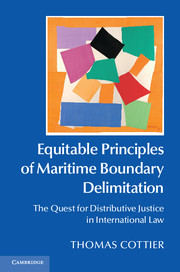 Equitable Principles of Maritime Boundary Delimitation
Equitable Principles of Maritime Boundary Delimitation Book contents
- Frontmatter
- Dedication
- Contents
- List of tables
- List of maps
- Preface
- Acknowledgements
- Table of cases
- Table of treaties and instruments
- Equity revisited: an introduction
- PART I Context: the enclosure of the seas
- PART II The new boundaries
- PART III Delimitation based on equity
- Appendix I Maritime boundary agreements 1942–1992
- Appendix II General maps
- Bibliography
- Index
Equity revisited: an introduction
Published online by Cambridge University Press: 05 May 2015
- Frontmatter
- Dedication
- Contents
- List of tables
- List of maps
- Preface
- Acknowledgements
- Table of cases
- Table of treaties and instruments
- Equity revisited: an introduction
- PART I Context: the enclosure of the seas
- PART II The new boundaries
- PART III Delimitation based on equity
- Appendix I Maritime boundary agreements 1942–1992
- Appendix II General maps
- Bibliography
- Index
Summary
The way is equity, the end is justice
Aroa Mines Case, Frank Plumley, Umpire, Venezuelan Arbitration of 1903, Ralston's Report p. 385–7The renaissance of equity
A. New frontiers
The enclosure of the seas in the twentieth century silently, but fundamentally, reshaped the geographical allocation of marine resources between coastal states. The partial return to a philosophy of mare clausum amounts to the most profound revolution of quasi-territorial jurisdiction of nations over natural resources embedded at sea. The new territorial allocation was prompted by the emergence of the continental shelf doctrine in the 1950s and of the exclusive economic zone (EEZ) in the 1970s, both today codified by the 1982 United Nations Convention on the Law of the Sea. The movement brought about new and fundamental challenges within the Westphalian system of nation states. Claims and responses to maritime resources called for an assessment of the newly emerging customary law and, subsequently, of treaty law. This resulted in the allocation and fine-tuning of jurisdiction and control over mineral resources, including oil and gas, and living resources, in particular fisheries. Allocation resulted in horizontally shared rights over resources, derived from the extension of land masses of coastal states. The doctrine of the continental shelf was based upon the extension of the land mass. Today, the concept of the continental shelf combines the criteria of natural prolongation with that of distance, extending to a minimum of 200 nautical miles (nm). At least within those 200 nm, both the continental shelf and the coincident EEZ rely upon the configuration of the coast. The enclosure movement resolved problems of competing claims under the doctrine of the freedom of the seas. It brought about new rights and responsibilities for coastal states. But it also brought about new and fundamental questions of distributive justice on two principal accounts. Both triggered a renaissance of equity in international law.
- Type
- Chapter
- Information
- Equitable Principles of Maritime Boundary DelimitationThe Quest for Distributive Justice in International Law, pp. 1 - 42Publisher: Cambridge University PressPrint publication year: 2015


